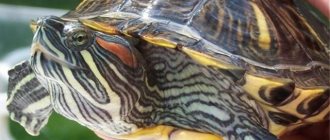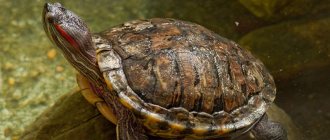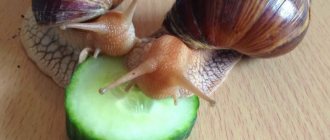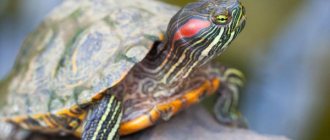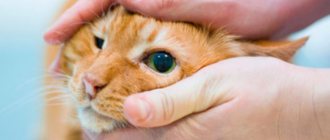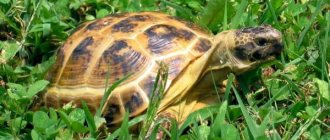The red-eared slider is a popular pet. Bright color, unpretentiousness in food and low price have made this breed a frequent inhabitant of home terrariums.
Not all owners follow the rules for caring for and feeding their pet. Most often, the red-eared turtle does not eat, is lethargic and sleeps due to unsuitable conditions.
Diseases
When a red-eared turtle gets sick, it completely loses its appetite. The reptile may suffer from pneumonia, constipation, helminthic infestations, etc. But in addition to refusal to feed, other symptoms are observed in this case.
A herpetologist can determine the reason why the turtle stopped eating. He will select treatment, perhaps prescribe vitamins. In addition, the specialist will tell you how to get the turtle to eat.
If you discover signs of illness in your pet, you should not delay a visit to the veterinarian, otherwise everything may end in the death of your pet.
How to determine if your pet is hibernating
It is quite difficult to distinguish hibernation from death if you do not know certain signs of a living reptile in suspended animation and a dead turtle.
What signs indicate the death of a pet:
- Open mouth.
- Lack of response to light and pain. Shine a light into the reptile's eyes and try to prick its paw with a toothpick.
- Sunken eyes (does not always indicate death).
- Unnatural color of mucous membrane. In living individuals it has a pinkish tint, in dead ones it is gray with a bluish tint.
- Lack of response to heat. Place the reptile in warm water or near a light heat source.
- Rotten corpse smell. The smell appears a couple of days after death. You will most likely notice obvious external signs of decomposition.
If the signs of death are not obvious, for example, sunken eyes, you should contact a specialist at a veterinary clinic, who will determine what is wrong with your pet.
Improper care
The red-eared turtle is a cold-blooded animal; in order for it to be comfortable, the ambient temperature should be from 26 to 35 degrees.
A UV lamp is required to maintain the required temperature. You also need an incandescent lamp with a 40-watt bulb, which must be turned on for 12 hours a day.
When reptiles are cold, they not only refuse food, but also look lethargic, float on the surface and cannot dive. As soon as the ambient temperature is optimal, the animals’ appetite will normalize. If this does not happen, then it is not a case of hypothermia and the help of a veterinarian is required. It must be remembered that overheating is just as dangerous for reptiles as hypothermia.
Who is better boy or girl
Visual differences between males and females in turtles appear after puberty is complete. Until two years of age, it is impossible to accurately determine whether a boy or a girl is hiding under the shell. For solitary confinement, the difference is not fundamental.
Females of any turtle species will carry out their natural program of laying eggs, even without contact with a male. If more than two years have passed since the last meeting with a representative of the opposite sex, there will be no offspring. The reptile's body requires vitamin support during this period. In rare cases, the process can negatively affect the health of the pet. Male land turtles are usually noisier than females. They are more active and more likely to show aggression.
If you need to choose a second turtle, the introduction will have to be carefully planned. Boys of any breed rarely get along with each other. Girls are more suitable for pair housing. When an opposite-sex couple lives together, the male can oppress the female. Turtles feel comfortable alone.
Stress
When you just bought a reptile, it is not surprising that it refuses food. It can take her a day to get used to her new place of residence. The animal is stressed, so she refuses to eat. As soon as the pet gets used to the new conditions, it will begin to take food.
At first, you shouldn’t stand near the terrarium for a long time, much less knock on it. Until the animal gets used to it, you should not try to pick it up, so as not to unnerve your pet again.
Moreover, you should not handle baby turtles; babies are very timid and this can become stressful for them; as a result, they stop eating and may even get sick.
Causes of loss of appetite
There are many things you should pay attention to to help your turtle feel the joy of life again. Some of the possible reasons that could deprive the mammal of calm:
- Getting used to a new environment;
- Adaptation in captivity;
- Disease;
- Stress;
- Intestinal problems;
- Extreme temperatures (cold or hot);
- Puberty;
- Poor nutrition.
The main reasons for the reluctance to eat are considered to be stress from a change in habitat and hypothermia of the animal. From the transportation process itself, the reptile’s nervous system can be severely damaged and it will take more than one day to recover.
Improper feeding
Perhaps the red-eared turtle does not eat because it is given the wrong food. She needs animal and plant food. Reptiles should be given lean meat: beef, poultry, horse meat is also suitable. But pork and lamb are contraindicated for turtles, since they are too fatty and the animal’s gastrointestinal tract is not designed to digest them.
In addition to meat, your pet can be given offal. To prevent calcium deficiency in the reptile's body, the diet should include shrimp and low-fat sea fish, which should be given along with bones. You can give raw snails and squid.
But in the absence of plant food, the animal will develop hypovitaminosis and other health problems. You can give dandelion and plantain leaves, carrots, beets, pumpkin, cucumbers, and zucchini.
The older the pet is, the more plant foods should be included in its diet.
But small turtles may refuse if they are given vegetables and fruits; they prefer animal food.
You should not give your pet boiled or fried foods, bread, or dairy products (except cottage cheese).
It is also important to follow the reptile's feeding schedule.
She may be fed too often and given too much food. While the turtle is small, its age is less than 12 months or its size is less than 10 cm, it is fed daily. Adults are given food 2-3 times a week. To determine the volume of one serving, you need to see how much the reptile eats in 30 minutes and give this amount constantly.
Conditions for keeping red-eared turtles
For one animal you need an aquarium with a volume of one hundred to one hundred and fifty liters and land connected to water using a rough ladder. If there is insufficient space, the turtle will not swim or move.
In addition, the following conditions must also be met:
- The surface of the land in the turtle's home should be large enough, sloping, rough and gradually rising. Special islands sold in stores meet all the necessary requirements;
- The water temperature in the aquarium should be higher than room temperature. To heat it, you should purchase a thermostat;
- the air above the island should also be warm, so it is recommended to install an incandescent lamp above it;
- the island should be at a level of thirty centimeters from the edge of the aquarium. If it is located close to the edge, nimble pets can escape;
- The water is cleaned using external aquarium filters. The frequency of water changes depends on their effectiveness. The cleaner the water in the aquarium, the faster the young turtles will grow;
- animals need sunlight, so in the summer they need to be walked with, and in the winter irradiated with ultraviolet light. A UV “Tanning Lamp” is suitable for this; it will need to be used three times a week for four minutes at a distance of thirty to fifty centimeters.
During a walk, the animal should be protected from direct sunlight, walking dogs and crows.
Mating season and other reasons
In captivity, the reptile grows faster and reaches sexual maturity earlier. When the male reaches 10 cm in size, he is ready to mate.
If your pet remains active but ignores food, it may have reached sexual maturity. During the mating season, male turtles are very restless and often have no appetite at all. There is no need to worry; as soon as it passes, the reptile will begin to eat.
Although in captivity the reptile rarely hibernates, with the arrival of autumn the red-eared turtle does not eat, is lethargic and sleeps. In this case, you don’t need to do anything; as soon as January comes, everything will return to normal. It is necessary to maintain the same temperature regime and dose of UV rays; the pet will survive the fall, but will be a little less active.
If, after all, the animal has fallen into hibernation and does not open its eyes, then you need to be prepared that it will sleep for 1-2 months. You need to place your pet in a small house, pour 10 cm of sand on the bottom and pour a little water to maintain humidity. After this, over 1.5 weeks, you need to gradually reduce the ambient temperature to 8-10 degrees. Your pet should be checked regularly during hibernation.
If there are several turtles in the terrarium, then perhaps they take each other’s food. In this case, you need to observe the reptiles and if you notice that one of them does not have enough food, then during feeding it should be removed and given food separately.
Why doesn't the red-eared slider eat?
The reasons for loss of appetite range from improper care and puberty to the environment in the terrarium and diseases.
Improper feeding
Feed your pet specialized food and approved products. Poor nutrition will cause not only loss of appetite, but also all kinds of intestinal diseases. The diet of an adult red-eared turtle necessarily includes meat, sea fish with bones, shrimp, and plant foods.
It is impossible to force a turtle to eat food it does not like.
Young individuals will not eat vegetables.
Binge eating
Often the animal refuses food when fed excessively. Young animals eat every day, and adults feed once every 2 days. Normalize the food system, watch your pet to find out how much food he needs.
If the portion is not eaten completely, the amount of food should be reduced.
Diseases
Diseases of internal organs do not manifest themselves externally. If the animals are lethargic, refuse to eat, and constantly try to sleep, then only a veterinarian can determine the cause. He will prescribe the correct treatment, recommend vitamins, and advise on diet.
Improper care
The most common mistake in content. Make sure that the temperature is maintained consistently within the range required for the specific breed. Reptiles cannot maintain their body temperature on their own. When exposed to hypothermia, they become lethargic, refuse to eat, get sick and die.
Aquatic rocks exhibit a lack of heat, remaining exclusively on the surface. If the reptile does not swim at all, pneumonia is possible.
Stress
Animals are subject to stress. Loud sounds, sudden movements, sudden changes in usual conditions - these factors lead to a refusal to eat. Eliminate sources of stress and your appetite will gradually return.
Overwintering
An individual hibernating accordingly refuses to eat. The pet becomes lethargic and inactive, constantly sleeping. Veterinarians do not recommend such overwintering at home, as it carries a risk of death of the animal. To avoid hibernation, ensure a constant temperature of around 30 degrees and clear daylight hours, or consult a professional.
If your pet is not eating on the 5th day after coming out of hibernation, take him to the vet. You may be exhausted, dehydrated, or have gout or liver failure.
Mating season
During puberty, males become more active, but eat much less than usual. After the mating season ends, food consumption will return to normal.
Change of living conditions
If your environment changes abruptly, it will take time to get used to it. Follow the animal’s usual routine and diet. Having gotten used to the new place, the pet will begin to eat. If you want to change the feeding plan, do it once the animal has settled down.
Getting used to captivity
Wild individuals trapped in a terrarium experience stress and often refuse food for a week. Be patient and create conditions in the room that are close to natural. If, even after habituation, the turtle does not eat well, reconsider the diet.
Constipation
When constipated, a turtle will not eat anything. If your pet hasn't had a bowel movement in a while, consult your veterinarian to determine the exact problem.
Suppression of weak individuals
Males can be quite aggressive towards each other. And the suppressed individual may not receive enough food or refuse it altogether. This state of affairs threatens the life and health of the animal.
Solution
When owners notice that their pet refuses to eat, they have a question about how to force the red-eared turtle to eat. First you need to create optimal conditions for the reptile, be attentive to the animal, offer it various types of food. You need to feed your pet at the same time so that he gets used to it and waits for this hour. If a turtle has symptoms of a disease, it should be shown to a specialist as quickly as possible; you should not treat it yourself, since only a veterinarian can make the correct diagnosis and prescribe adequate therapy.
How to extend the life of a turtle
To prolong the life of a red-eared turtle, it is enough to protect it from diseases and unfavorable conditions. A properly sized terrarium, balanced food, a heating lamp, quarantine for new individuals and timely inspections at least once a month - all this does not require much time, but can serve well.
A pet whose care is given enough attention may well become a long-liver and become familiar to several generations of the same family. To do this, you should get a young individual, for the purchase of which you need to equip a spacious terrarium.
Check the turtle's environmental temperature
If your box turtle's environment is not warm enough, its metabolic rate will decrease. Consequently, he will not be interested in eating because he is trying to conserve energy to stay warm.
For those who have a pet three-toed box turtle, eastern box turtle or Gulf Coast box turtle, daytime enclosure temperatures should be around 24 C with basking areas between 29.4 and 31 C. Night temperatures should remain above 21 C Some other varieties of box turtles require slightly higher temperatures, so it is important to know your turtle's individual needs.
A little about the red-eared slider
The red-eared beauty comes from America, it’s not for nothing that its second name is American turtle . This pet will be a great friend because... At home and with proper care, turtles are active and very hardy.
These pets often have a distinct personality and character, and are very intelligent and quick-witted.
If you have two individuals, you can observe the aggressive antics of the red-eared slider - taking food, fighting, rivalry.
At home, turtles live quite a long time, up to 40 years.
Another pleasant bonus of purchasing such an animal is the absence of allergies to it. The red-eared beauty is known for its striking olive-colored coat, with a red stripe running across its entire body.
The size of an individual varies - from 3 cm to 30 cm, and it is worth considering that at home, red-eared turtles develop much faster than in nature.
A turtle can make characteristic sounds - hissing, squeaking or snorting.
What to do?
The reason why the red-eared turtle has lost its appetite can be eliminated either independently or with the help of a veterinarian. It all depends on how serious the situation is.
If you feed frequently, you should reduce the amount and start giving as much food as the turtle can eat at one time. Leftover food is removed immediately , otherwise it may spoil, which will lead to illness if the turtle decides to finish it. Most often you can give vegetables and herbs. Adult turtles are mainly herbivores, so they are fed protein foods periodically.
When preparing a turtle for hibernation, you need to bring it out of this state. Reptiles of this species hibernate under certain conditions that are almost impossible to create at home. A turtle may fall asleep and never wake up, especially if for some reason it is weakened and exhausted.
In the aquaterrarium, you need to increase the water temperature to 28 degrees, make the lighting brighter and longer. Daylight hours should be increased by two or three hours.
When keeping male and female red-eared turtles in the same aquarium, you can observe their mating games. Upon completion of mating, the animals will begin to eat, so you should just wait, since nothing will be done in this case.
It should be noted that for female turtles of this species, sexual maturity occurs at the age of four years. Males are ready to reproduce at the age of five. Therefore, if the reptiles are younger, the reason for refusing to eat lies elsewhere.
It is advisable to determine the symptoms of a sick turtle . When there are no visible causes and the development of the disease has not been identified, it is advisable to consult a veterinarian. During the examination, possible causes of the disease will be identified, the correct treatment will be prescribed and the necessary manipulations will be carried out. In addition, the veterinary clinic will give the necessary recommendations for further care of the turtle. Very often, experts recommend taking special vitamin complexes for freshwater reptiles.
It is strictly forbidden to self-treat your pet . In most cases it will be incorrect and may make the turtle's condition even worse.
